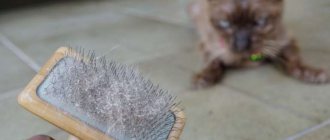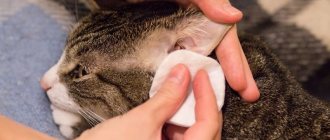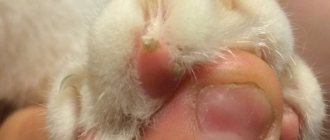One of our readers asked us what it means when a cat keeps scratching its neck. In this case, there is usually an underlying problem that needs to be solved. In this post, we'll look at some of the most common causes of an itchy neck and explain how to solve such problems to give your cat some much-needed relief. First, let's look at the possible answers to this question.
Cats that won't stop scratching their necks usually have parasites, such as fleas or ticks, that need to be addressed. The healing wound may also be itchy and could finally be an allergic reaction to things like house mites or something in your cat's diet.
Signs of a pathological condition of an animal
Cats regularly look after their fur, licking themselves, scratching, and biting. But as the disease progresses, the pet’s behavior changes. If the following symptoms occur, you need to examine the animal and contact a veterinary clinic:
- Frequent scratching, the cat biting its fur and meowing pitifully.
- Constant biting of skin.
- Formation of bald patches, deterioration in the appearance of the coat.
- The appearance of dandruff and oily scales on the neck.
- The appearance of ulcers, red rashes, and spots on the neck.
- Detection of parasites and/or their metabolic products on the pet’s skin.
Frequent scratching of the neck is an alarming symptom
Otitis
Ear infections can also cause unbearable, severe itching, causing the cat to shake its head and scratch its face and ears vigorously.
In advanced cases, you may notice redness and swelling of the auricle, as well as discharge of pus from the ear itself.
The first sign of otitis in cats is severe itching in the ears.
Secondary symptoms:
- Inflammation of the skin inside the ear.
- Sharp or aching pain (the cat becomes lethargic or aggressive, scared).
Causes:
- Injuries. Contact with foreign objects, scratches, fights between tribesmen.
- Parasites (ear or subcutaneous mites). They damage the skin and soft tissues, a bacterial infection is added and otitis media develops.
- Allergy. In this case, the cat scratches the skin inside the auricle, an infection gets there, which is the cause of otitis media.
- Infection with staphylococcus, streptococcus, etc.
- Incorrect care.
Causes of itching
Traditionally, the search for causes begins with excluding fleas. The cat is examined by ruffling the fur so that the skin underneath is visible. If fleas are found, the animal is treated with a special flea remedy or bathed with an appropriate shampoo. Even after eliminating the parasites, a substance remains in the pet’s blood, which enters the body when a flea bites. Therefore, itching may persist for another 4-6 weeks after the cause has disappeared.
Hormonal and endocrine disorders
Failures in metabolic processes and changes in hormonal levels can cause itching. Only a veterinarian can identify the cause of the disorder and select effective treatment. It is recommended to go to a large clinic that offers hormone testing.
Allergic reactions
If an animal is hypersensitive to a particular food or food component, the pet begins to comb its face, paws, and ears. A food allergy can be detected through a diagnostic diet, which involves changing the diet to identify the trigger component.
Non-food allergies are characterized by itching as a reaction to anything other than food:
- Insect bites, fleas. Cats scratch bite sites. If there are fleas, there is itching on the back of the back, belly, and tail.
- Dust, flower pollen. In summer, this type of allergy gets worse.
- Individual intolerance. A rare type of allergy called contact allergy. The chest and stomach of the cat are affected. To find out exactly what substance the reaction occurred to, you need to conduct allergy tests.
Ringworm and other types of skin mycoses
Dermatomycosis is a fungal disease in which a cat scratches its neck, hair falls out at the scratch site, and clearly defined spots form. Only a veterinarian can identify the type of pathogen and select therapy.
You should not try to cure the cat yourself - this may worsen the disease. A person can get lichen after contracting it from a cat. The ringing type is especially dangerous. There is no need to waste time; it is important to get your pet to the clinic as soon as possible.
If your pet is found to have lichen, it should not be bathed. Otherwise, the pathology will worsen and the spots will spread throughout the purring body.
Dermatomycosis is a dangerous fungal disease
Infectious lesion
Infectious agents enter the house through the owners' shoes, then spread to the animal's fur and skin. If a cat has wounds or even small scratches, the infection gets into them and causes inflammation and suppuration. To eliminate pathology, ointments and powders are used. For humans, this pathology does not pose a threat.
Helminthiasis
Not all owners of purring dogs know that itching and scratching on the neck can be a consequence of helminthic infestation. Parasites disrupt metabolic processes in the body, and the pet does not receive the necessary nutrition. As a result, the skin dries out, dandruff and itching appear. Helminths also cause the development of an allergic reaction, manifested by a rash and itching. The pet suffers greatly and itches until it bleeds.
Infections can be caused by food or contact with contaminated objects:
- raw meat/fish;
- insect (flea) bites;
- sick animal;
- owner's shoes.
If you suspect a helminthic infestation, you need to have your pet's stool tested. The cat is prescribed a course of anthelmintics. For prevention, you should regularly give your animal anti-worm medications, such as Albentabs, according to a schedule.
Parasites pose a threat not only to cats, but also to people. The risks of infection are especially high among young children, as well as owners who let their pets into their beds.
External parasites
In addition to fleas, the animal may have other external parasites that provoke scratching of the neck:
- Ear mite. The pet constantly twitches its ear and the area near it, tilts its head to one side. Often the result is severe bloody scratching.
- Sarcoptic mange (scabies mite). Accompanied by severe itching. It can appear on any part of the cat's body.
- Cheyletiellosis. Rarely seen. Appears as white moving dots located along the back. The disease is popularly called “pityriasis” scabies.
- Lice. Provoke itching. Parasites can be seen in your pet's fur.
Itching may be caused by external parasites
Psychological problems
Cats, like people, are susceptible to nervous tension. A purr may scratch its neck vigorously due to nervousness, having experienced stress from moving, or the appearance of a new person (child) or animal in the house. To normalize the condition, the pet is given a herbal-based sedative, for example, “Cat Bayun”.
Why does a cat scratch its neck?
There are many reasons that cause itching other than flea infestation. The problem may lie either in the activity of other parasites or in individual intolerance to certain substances.
Parasites
When the most obvious cause of neck scratching, namely fleas, has been ruled out, you should not immediately stop looking in this direction, because other types of parasites may also bother the animal. So, itching can be provoked by:
- Subcutaneous mites that cause demodicosis - a disease that affects the skin and coat of a pet. In the localized form of the disease, the lesion occurs in a separate area of the body, for example, on the neck. In this case, the skin turns red, pustular rashes appear, the integument peels off, and the hair on the head, ears and neck falls out. The animal is primarily concerned about severe itching and the appearance of bleeding wounds, which are further scratched with claws. Cat subcutaneous mites of any kind are not infectious to humans. Two types of such parasites can live on a cat’s body: Demodex cati, which is conditionally pathogenic (it is part of the normal flora, but under favorable conditions it can multiply and cause disease),
- gatoi, a scabies mite that belongs to a pathogenic species and can be transmitted from one individual to another.
The gatoi scabies mite causes severe itching in cats and can be transmitted to other pets, but not to humans.
Dermatological diseases
Skin diseases can be caused by both changes within the body and pathogenic microorganisms:
- Fungal dermatological diseases (dermatomycoses) are a common cause of problems in cats, caused by mold and yeast infections. The most common disease in this group is lichen, the causative agent of which is the fungus microsporum, epidermophyton or trichophyton. The disease affects the hair follicles and skin. Ringworm is contagious and can be easily transmitted from cat to person, so owners should be vigilant, especially if there are small children in the house. The disease manifests itself in symptoms: round redness appears on the body, which itches and bothers the animal;
- peeling of the skin and hair loss are observed, which most often affects the area of the head, neck and limbs;
- When a secondary infection occurs, scratching can transform into festering wounds.
Ringworm most often affects the head, neck and extremities, causing itching, flaking skin and hair loss.
- traumatic - due to mechanical damage to the skin on the neck, burn or frostbite;
Allergic reaction
A nonspecific immune reaction to an irritant can occur in animals as often as in humans. Possible allergens that can cause itching in the neck area:
- feed;
- flea drops on the withers and an anti-flea collar;
- medications;
- shampoo and other hair care products.
An allergic reaction can be limited to local itching and redness, which causes the animal to itch a lot, or cause additional, more dangerous symptoms, including life-threatening swelling of the airways (Quincke's edema).
Video: a cat has an allergic reaction to a flea collar
Effective Treatments
Itching and scratchy wounds are a consequence of the disease. Until the cause is eliminated, it is impossible to relieve the itching. But before the animal gets to the veterinarian, its condition can be alleviated. To do this, wounds need to be disinfected with hydrogen peroxide, Chlorhexidine or Miramistin. You cannot use any cosmetics, such as shampoo, cream, wool powder.
To prevent the cat from licking the medicine from the fur, you should wear a special collar.
A special collar protects the animal.
Treatment methods are selected individually based on test results:
| Type of disease | Treatment |
| Demodicosis | Lasts up to a year. It involves a number of measures:
|
| Helminthiasis | Antihelminthic drugs are prescribed (Febtal, Panacur, Prazitel, Kanikvantel). |
| Bacterial infection | Prescribed:
|
| Eczema | Therapy should be comprehensive:
|
| Allergy | Necessary:
|
| Dermatomycoses | Therapy lasts up to 2 months and involves:
|
For treatment to be effective, you need to provide your cat with a balanced diet. Nutrition should be adjusted, even if the cause of the pathology is not a food allergy. A lack of vitamins and microelements negatively affects the condition of the skin and coat, and the speed of wound healing.
Infectious skin diseases
Itching in an animal can be caused by an infection that has penetrated into the thickness of the skin through scratches, small wounds, or flea bites. Local inflammation causes the cat to itch furiously, but bacterial infections can be treated well. Veterinarians advise using sulfur ointment or Juglone powder externally. These drugs cope equally well with dermatomycosis and bacterial infections. Systemic treatment may require antibiotics, but these medications should only be given to your pet as directed by a doctor.
Interesting!
Juglone powder, dissolved in an oil base, was rubbed into the skin for ringworm behind the cat's ear. After a few days, the lesion shrank, and after a week of use it disappeared completely. Juglone is a black walnut extract that is used in America to treat parasitic diseases. The drug has a bactericidal, sedative, antifungal, antiprotozoal and immunomodulatory effect. According to expert reviews, the product copes well with skin problems in animals. We have only recently begun to treat dermatoses with this medicine, and the drug is difficult to find on the market.
Juglone Infectious skin lesions in cats are secondary and are not transmitted to humans. Most often, people are the source of infection for cats.
Veterinarian advice
It is not recommended to curtail your pet’s freedom and lock it within four walls in an attempt to protect it from illnesses. Infection is possible through the owner's shoes and hands, even if the cat is domestic.
Veterinarians give some recommendations for caring for furry purrs:
- Keep your pet clean.
- Provide a balanced diet.
- Do not give your cat smoked meats, salty foods and sweets.
- Protect the animal from stress and pay attention to it.
Keeping your pet clean Balanced diet Attention from the owner
The cat licks and itches, but there are no fleas
In addition to the presence of fleas, increased attention to fur may be caused by the following reasons:
- allergic reaction;
- fungal infection;
- changes in hormone levels;
- excess or lack of vitamins in the body;
- changes in diet.
The cat licks itself vigorously and goes bald
Itching may have a psychological cause. For example, a pet experiences stress if it does not have the opportunity to mate. The cat can be calmed using a sedative.
Cat licks after sterilization
After surgery, a stitch remains on the pet’s abdomen, which can pull and itch. To avoid injury to the suture, put a collar on the cat until the wound heals.
What to do if your cat is constantly licking
It is difficult to independently identify the cause of your pet’s behavior. He should be examined for fleas, lichen spots, and wounds. It is important to analyze your recent lifestyle, changes in diet and hair products. You need to tell your veterinarian about all changes, this will help with diagnosis.
If your cat is constantly licking you need to take her to the vet.
Ringworm and other skin lesions in cats caused by fungi
If an adult animal or kitten itches, but there are no fleas, the itching is often associated with the action of a fungus on the skin.
Trichophytosis, ringworm
Trichophytosis is a fungal disease that can be transmitted to people. This is especially dangerous for children, and it is much easier to cure a pet than a person. The disease manifests itself as hair loss in a local area and increased itching of the affected area. As a result of infection, since the pet is constantly itching, an abscess covered with a hard shell often forms under the skin of the bald spot. In this case, it is necessary to remove the pus, but the procedure must be performed by a veterinarian in a clinic setting.
You should not diagnose the disease yourself, since it is easy for an amateur to confuse ringworm (the popular name for trichophytosis) with other effects that have similar manifestations:
- sunburn, especially typical for representatives of short-haired breeds;
- damage from exposure to chemicals;
- hormonal alopecia.
If the diagnosis is established, special ointments offered by veterinary pharmacies are used.
Dermatomycoses
They arise from the infectious effects of fungi. Pets become infected from other animals, unwashed food, dirty objects, and unfavorable living conditions. The disease is often carried by mice.
Characteristic manifestations are scratches, wounds, scratches, reminiscent of those caused by fleas, covered with crusts, constantly itching, disturbing the cat and forcing it to itch.
Preventing itching
To avoid the development of diseases accompanied by itching, you should adhere to the following rules:
- Regularly give your pet deworming medication and do not feed it raw meat or fish.
- After returning the animal to the house from the street, inspect for wounds and cuts, and if found, treat them with an antiseptic.
- Protect from contact with infected animals.
- Periodically disinfect your pet's litter box.
- Transfer the cat to a new diet gradually.
- Protect your pet from stress.
If your cat experiences itching, you should consult a doctor. You cannot try to identify and eliminate the disease yourself.
Recommended Posts
How to remove fleas from a dog or 9 ways to combat parasites
How to Diagnose and Treat Flea Flea Dermatitis in Dogs
How to choose and correctly use flea treatment for cats
How to use Bars drops for cats and other preparations: spray, shampoo
History of origin and characteristics of the British cat
Causes and methods of treating acne in cats
Prices for appointments in our clinics
| Name of veterinary services | Unit | Price, rub |
| ⭐ Initial appointment | 1 animal | 400 |
| ⭐ Repeated appointment | 1 animal | 250 |
| Initial appointment with a specialist | 1 animal | 1100 |
| Consultation without an animal | — | 550 |
| Consultation with a doctor based on test results | 1 PC. | 400 |
| Weighing animals | 1 animal | For free |
| Additional fixation for aggressive animal behavior | 1 animal | 700 |











